I once tried to haul a small sedan with a basic utility trailer. Bad idea. The ramp bent. The load shifted. My truck felt like it would tip over.
That was my wake-up call. Not all trailers are made for cars.
I’ve worked with trailers for years now. I’ve tested, loaded, unloaded, and repaired more than I can count. I’m not a salesperson—I’m just someone who’s learned from real work, real loads, and real mistakes.
You’re probably here wondering: “Do I need a utility trailer or a car hauler?”
You want a straight answer. You’ll get one.
This article will show you the key differences. Build, capacity, use cases—everything. By the end, you’ll leave with a clear answer and the confidence to make the right call.
So let’s start!
1. What is Utility Trailer?
Think of a utility trailer like a flatbed that does a little bit of everything. It’s open, has short side rails, and comes in many sizes.
I bought my first utility trailer to move lawn equipment. Then I used it to haul plywood, scrap metal, even furniture. That’s the thing—they’re flexible.
A utility trailer is a non-powered trailer with an open deck, made for general hauling. You hitch it to a truck or SUV. No fancy hydraulics or ramps. Just space to carry what you need.
Most have:
- An open flatbed
- Low or mid-height rails
- A drop-down gate (sometimes)
- One or two axles
They’re popular because they’re light, easy to store, and can haul just about anything that fits.
But here’s the truth—they’re not made for cars. I found that out the hard way. The deck’s too narrow. The ramp’s not strong enough. And the tie-down points? They’re made for boxes and lawnmowers, not wheels and axles.
So before you load up something heavy or low to the ground, stop and ask yourself: Is this trailer built for the job?
Utility trailers are great for a lot of things. But they’re not always the right answer. And if you do need one—go with a trailer from Rhinotrail. Each unit is rigorously tested, including 150% load tests before shipping.
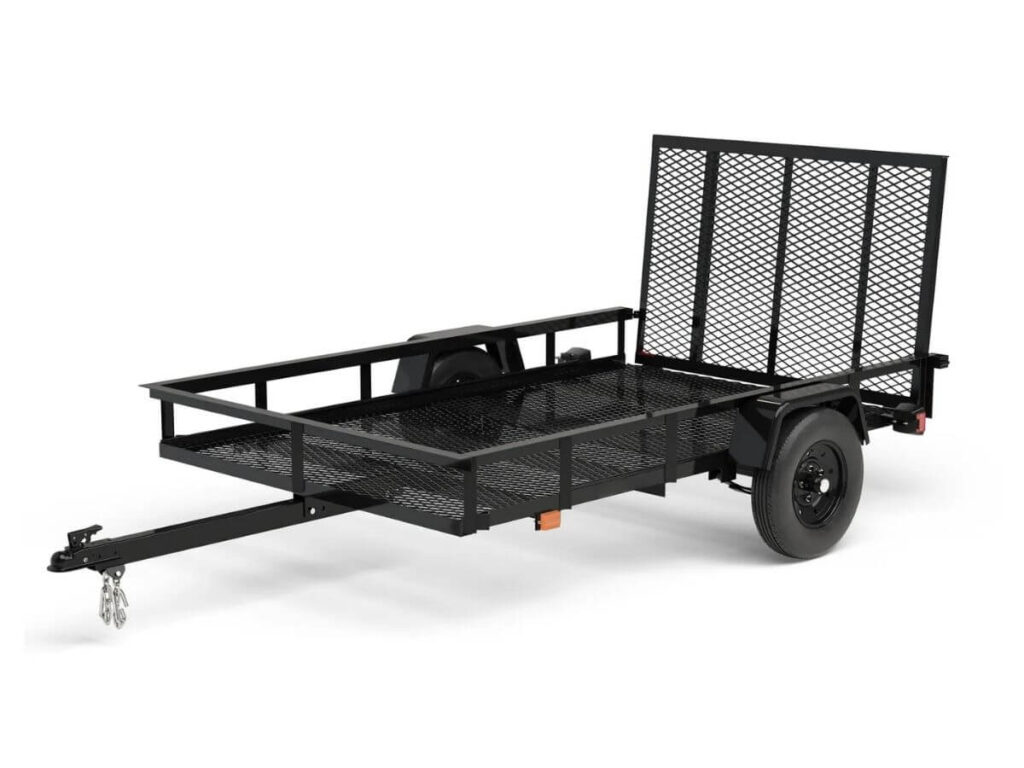
2. What is a Car Hauler?
A car hauler is built for one job—moving vehicles safely and smoothly.
I didn’t get that at first. I thought my utility trailer could handle everything. Until I tried loading a car. It was too low, too heavy, and didn’t sit right. That’s when I learned what a car hauler really does.
A car hauler is a trailer made with ramps, low deck height, and strong tie-down points. Everything about it is designed for vehicle weight and size.
Here’s what most car haulers come with:
- Long ramps or tilt beds for easy loading
- Wider decks for car tires
- D-rings or wheel straps for tight holds
- Tandem axles for weight support
Some have open decks. Others are enclosed. You’ll see them at dealerships, auctions, and race tracks. And yes, they’re heavier than utility trailers—but stronger too.
If you’re moving a car, ATV, or off-road truck, this is the trailer you want. You don’t need to mess around with makeshift ramps or guess where to strap it down.
So ask yourself—are, are you moving general cargo or rolling machines?
If it has wheels, a car hauler might save you a lot of headaches.
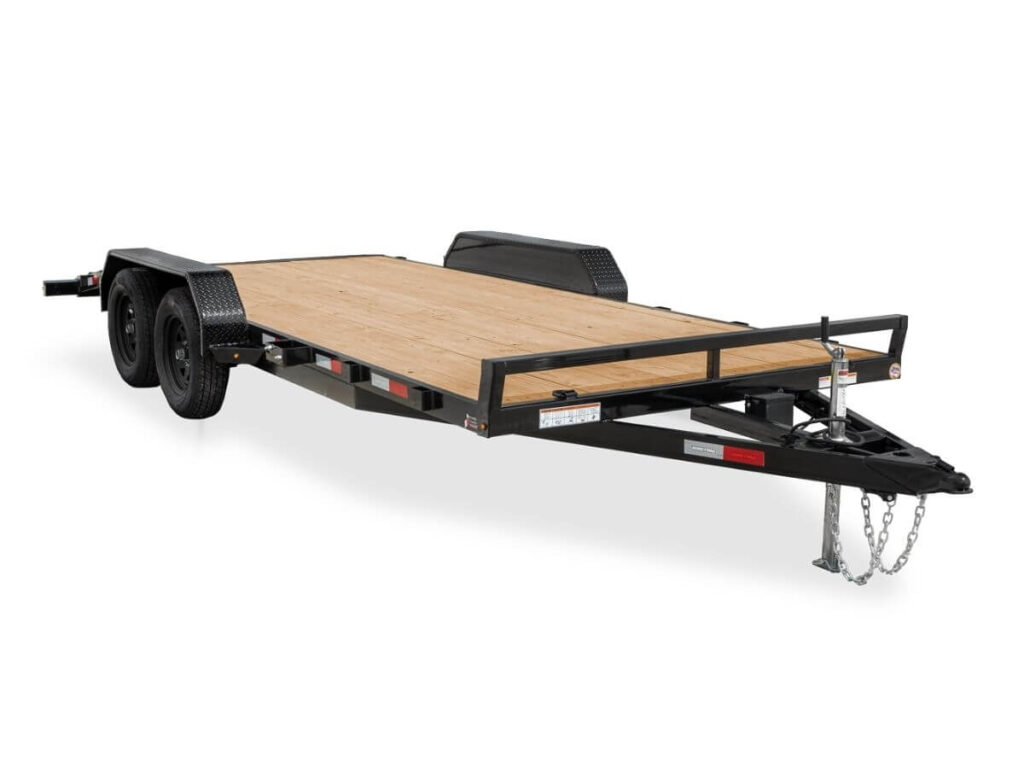
3. Loading and Unloading Features
How you load and unload matters more than you think. I learned this after trying to move a low car with a basic ramp—it didn’t end well.
Some trailers make the process simple. Others turn it into a headache. Let’s break it down.
Utility Trailer Loading/Unloading Options
Utility trailers keep things simple. Most of them come with a fold-down rear gate. This acts as a basic ramp—perfect for wheeling in small gear. Some models offer a tilt bed, where the trailer tilts back to let gravity do the work.
These are great for:
- Yard tools
- Pallets
- Light equipment
Need to load by hand or with a dolly? No problem. But here’s the downside—they’re not built for drive-on loads. I once tried getting a golf cart onto one. The ramp bent, and the angle was too steep.
So, if you’re moving lightweight cargo, a utility trailer works fine. But for anything with wheels and weight? You’ll want more support.
Car Hauler Loading/Unloading Features
Car haulers are made for rolling things up. Literally. They come with drive-on ramps or sometimes a hydraulic lift, which raises and lowers the deck.
These features make it easy to load:
- Cars
- Side-by-sides
- Lawn tractors
- Broken-down vehicles
They also come with safety features, like:
- Wheel stops to hold the load in place
- Tie-down points for ratchet straps
- Winches to pull up non-running vehicles
One time I helped a buddy load a car that wouldn’t start. The built-in winch saved the day. No pushing. No drama.
If you’re moving anything on wheels, these features matter more than you think.
4. Key Structural and Functional Differences
Not all trailers are built the same—and that’s the point. I learned this after bending an axle trying to haul something too heavy for my utility trailer. Structure matters. Let’s look at what separates these two types.
Utility trailers and car haulers might look similar at first glance—but they’re built for different jobs. I’ve worked with both, and trust me, the differences show up fast once you start loading.
Let’s break down what really sets them apart.
Frame and Deck Design
- Utility Trailer: Lightweight frame. Usually made with angle iron or light-duty steel. Many come with rails or mesh sides to hold loose cargo.
- Car Hauler: Heavier-duty frame. Built with channel or tube steel to carry vehicles. Flat, open deck with no side rails so cars can load easily.
Axle and Suspension
- Utility Trailer: Often has a single axle. Great for lighter loads but can bounce more on rough roads.
- Car Hauler: Usually comes with tandem axles. This helps carry more weight and gives better stability, especially at highway speeds.
Loading Setup
- Utility Trailer: Uses a fold-down ramp or tilt bed. Easy for tools, pallets, or small machines—but not strong enough for cars.
- Car Hauler: Built-in drive-on ramps or a dovetail. Some models use a hydraulic lift. Made for vehicles and heavy wheeled equipment.
Tie-Downs and Safety
- Utility Trailer: May have basic hooks or rails. Enough for yard gear or light loads.
- Car Hauler: Has strong D-rings, stake pockets, and sometimes wheel stops. Better for securing vehicles during long hauls.
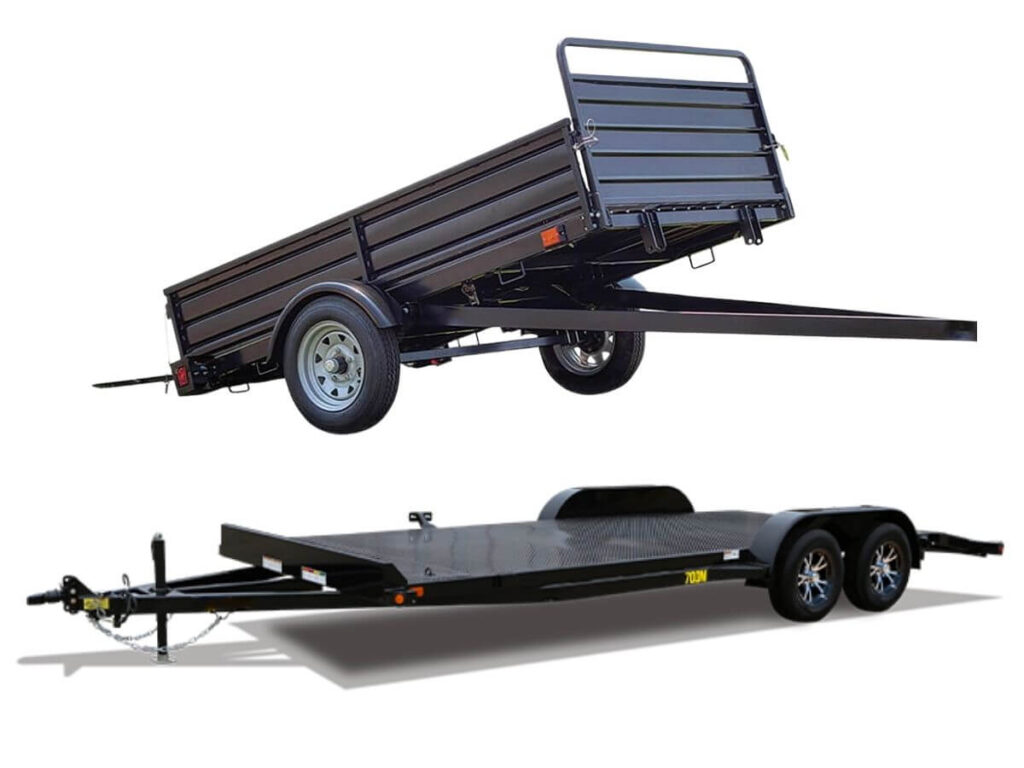
5. Maintenance Requirements
Maintenance doesn’t get much attention—until something breaks. I’ve been there. A worn tire and a loose wire once cost me a whole weekend job.
Keeping your trailer in good shape isn’t hard. But it does depend on the type you’re using.
Utility Trailer Maintenance
Utility trailers are simple, but they still need regular care. Here are the basics:
- Tire Pressure and Wear: Check your tires before every trip. Low pressure or bald spots can lead to blowouts.
- Rust on Frame or Rails: Look for rust around welds and corners. A little sanding and paint can go a long way.
- Lights and Wiring: Test brake lights, blinkers, and wiring plugs. Bad wiring can cause accidents or get you pulled over.
- Grease on Wheel Bearings: Bearings help your wheels spin smoothly. I re-grease mine every 12 months or 10,000 miles.
- Deck Maintenance (Wood or Metal): Wood can rot; metal can rust or dent. Clean it off after rain or snow to prevent damage. At Rhinotrail, our trailers are easy to maintain due to anti-corrosion coatings, sealed welds, and reinforced materials that stand up to tough weather and heavy use.
Car Hauler Maintenance
Car haulers handle heavier loads, so they need a bit more attention.
- Ramp Hinges and Hardware: Check for rust or loose bolts. Stiff or weak ramps can be dangerous during loading.
- Winch Cables: Inspect cables for frays or slack. A snapped cable under load is a serious safety risk.
- Hydraulic Parts: If your trailer has a lift, check fluid levels and seals. I once ignored a small leak—and the lift failed mid-load.
- Tie-Down Points and Straps: Look for worn hooks, bent rings, or torn straps. Securement failures are no joke.
- Brake System: Car haulers often have brakes on both axles. Test them regularly—especially if you’re hauling downhill.
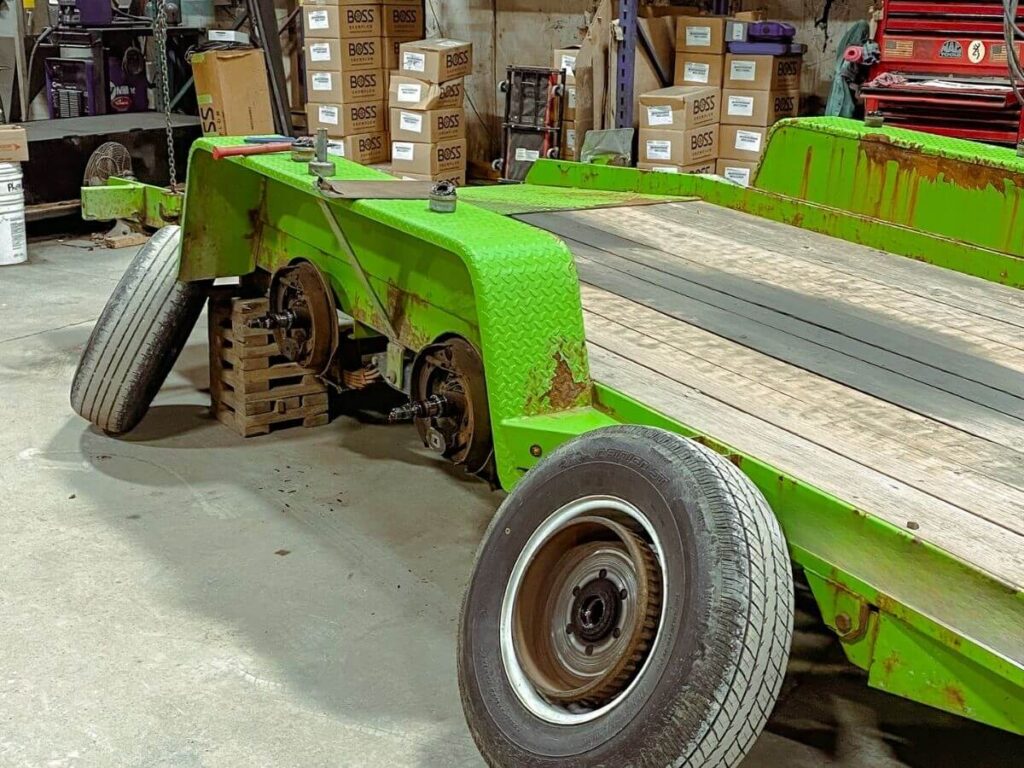
6. Cost and ROI Considerations
Price matters. I’ve had to balance budgets with hauling needs more times than I can count. The truth is, the right trailer isn’t always the cheapest—it’s the one that gives you long-term value.
Let’s look at what you’re really paying for.
Initial Purchase Price Comparison
If you’re buying your first trailer, you’ll notice the price gap right away.
- Utility trailers are more affordable. Most basic models range from $1,000 to $3,000, depending on size and build.
- Car haulers cost more because of extra features like ramps, stronger frames, and tie-down systems. Expect to pay $3,500 to $7,000+ for a quality model.
When I started, I went with a cheaper utility trailer—and it worked. But later, when I needed to move cars regularly, I had to upgrade.
Operational Costs Over Time
The initial price is just the beginning. You’ll also need to think about long-term costs.
- Maintenance: Utility trailers are cheaper to maintain, especially with single axles. Car haulers may need more brake checks, ramp upkeep, and winch repairs.
- Repairs: Ramps, lights, or hydraulic lifts (if included) can add to car hauler upkeep.
- Insurance: Car haulers often cost more to insure due to their size and cargo type.
On average, I spend about $150–$300/year maintaining a utility trailer. My car hauler? Closer to $400–$700/year, especially if I’m hauling long distances.
Return on Investment Based on Use
Your ROI depends on how often—and what—you haul.
- If you’re moving small loads now and then, a utility trailer gets the job done.
- If you’re hauling cars, equipment, or running a transport service, the higher upfront cost of a car hauler pays off over time.
For business use, I always recommend running the numbers. A trailer that fits your cargo saves money on breakdowns, reloading, and missed deadlines.

7. Industry-Specific Considerations
Different industries have different needs. I’ve worked with clients across sectors—from farm owners to fleet managers—and I’ve seen how the “right” trailer changes depending on the job.
Let’s look at how each industry should think about utility trailers vs. car haulers.
Construction Companies
For light-duty work like hauling tools, cement bags, or compact equipment, a utility trailer usually does the job. But if you’re moving skid steers, compact loaders, or mini excavators, a car hauler is the safer and smarter option. Its stronger frame and loading ramps can handle the extra weight. I’ve seen more than one utility trailer buckle under the pressure of construction gear.
Mining Industry
Mining environments are rough, and so is the equipment. If you’re hauling generators, welding rigs, or large tool containers, a car hauler gives you the support you need. Its heavy-duty frame and tandem axles are built for weight and uneven terrain. Utility trailers don’t usually hold up under that kind of stress.
Logistics and Transportation Firms
For transporting fleet vehicles or company trucks, car haulers are the go-to option. They offer stable, long-distance performance and secure tie-downs. On the other hand, if you’re running local deliveries or moving lightweight cargo like boxed goods or pallets, a utility trailer makes more financial sense. The trick is matching the trailer to the size and scale of your daily routes.
Agriculture and Food Distribution
On farms, utility trailers are common for hauling feed, fencing, and field tools. They’re light, open, and easy to tow across uneven ground. But when it comes to transporting small tractors, ATVs, or even livestock equipment on wheels, a car hauler does a better job. I’ve seen too many overloaded utility trailers struggle on gravel roads.
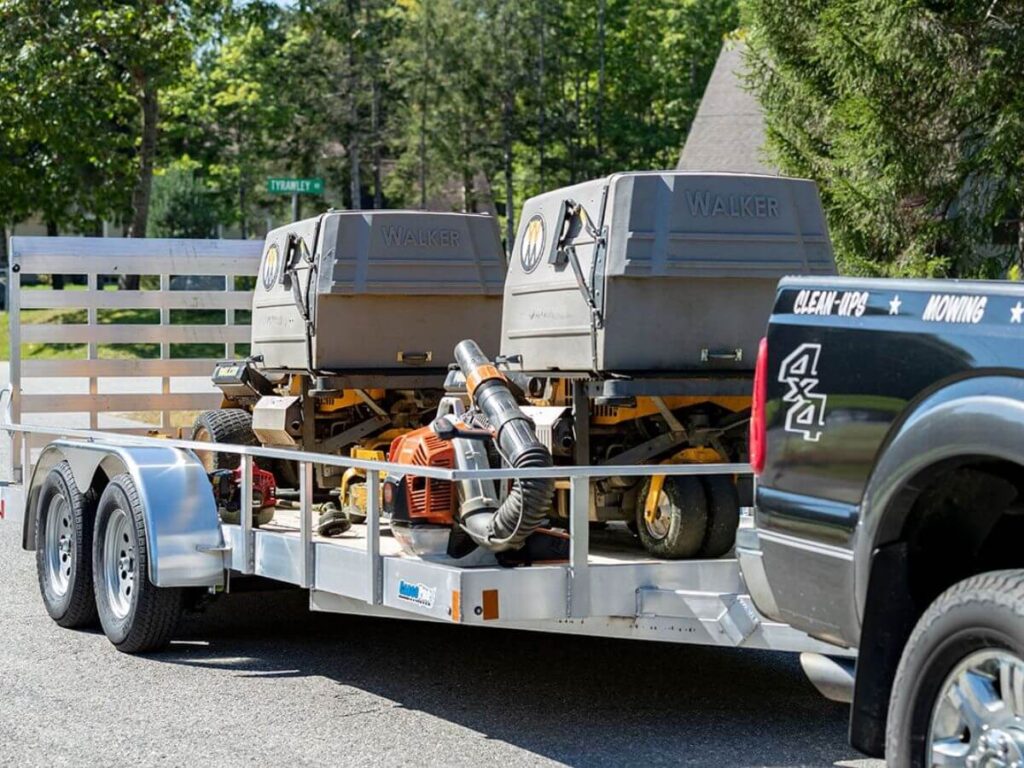
8. Which To Choose Between Utility Trailer and Car Hauler?
Picking the right trailer isn’t just about cost—it’s about what makes sense for the job. I’ve made the wrong choice before, and it always led to wasted time and extra stress. These tips can help you decide with confidence.
Match the Trailer to the Load
If you’re mostly moving tools, yard waste, pallets, or general cargo, a utility trailer will usually be enough. It’s lightweight, versatile, and simple to hook up and go. But if you’re dealing with cars, ATVs, or heavy machinery, you’ll need a car hauler. The stronger deck, ramps, and tie-down systems are made for that kind of work.
Consider How Often You Use It
If you’re hauling a few times a year, a basic utility trailer might give you the best value. But for weekly or daily use—especially for commercial work—a car hauler may be worth the higher upfront cost. It offers more support, durability, and safety when used regularly. Long-term use justifies the investment.
Think About Where You’re Driving
For short local trips, lighter loads, and city streets, utility trailers are easier to manage and store. But if you’re hauling long-distance or driving on highways with bigger loads, the stability and braking power of a car hauler makes a big difference. I’ve felt the trailer sway before—once was enough. A heavier-duty trailer adds peace of mind on open roads.
Check Your Vehicle’s Towing Capacity
Don’t forget to look at what your truck or SUV can handle. Car haulers are heavier, and when fully loaded, they can push your vehicle close to its limits. I once had to borrow a bigger truck just to haul safely. Matching your trailer to your tow vehicle keeps everything safer—and legal.
Conclusion
So—utility trailer or car hauler?
By now, you’ve got the answer. You’ve seen what each trailer does, how they differ, and when one makes more sense than the other.
I’ve made the wrong choice before. You don’t have to. Your cargo matters. Your work matters. So should your trailer.
Still unsure?
Contact us today—we’ll help you choose right trailer for your specific needs!


